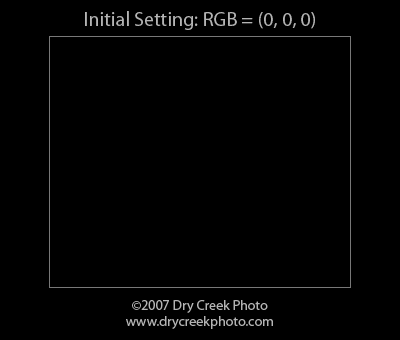The image below is based on a test developed by Bruce Fraser and detailed in his book Real World Color Management. The primary goals are to determine if the monitor black point is set correctly and find the minimum shadow level your monitor can display. This test works best if your browser window is set to full screen mode, as that minimizes the amount of pure white showing. That is also why the text and links on this page are subdued grays. The next page in this series has an image to help evaluate you monitor's grayscale sensitivity across the full tonal range.
The animated gif ramps the monitor output up in steps of 1 RGB unit. The starting point is pure black: RGB = (0, 0, 0). The first step highlights the central square. Each following step increases the output level by one unit. A top quality monitor using an excellent calibration system can show the difference between levels 0 and 1. Average monitors will not show any increase in output until level 5 to 8
If you do not see anything until level 11 or 12, one of several problems is at fault. The most common culprit is overly bright ambient lighting. Even with today's bright LCD screens, working under subdued lighting is necessary for seeing shadow details. Also, monitor calibrators are affected by ambient light to some extent. Recalibrate your display in dimmer light; this often solves many a problem. Assuming the lighting is good, try calibrating your monitor to a higher black point. The selected point may simply be too low for your screen to resolve differences in shadow levels.
It is better to have the black level set slightly too high than too low. The goal is to be able to distinguish pure black from nearly black. A low setting clips shadow details and places your monitor in an unstable state. On a CRT monitor, the black level can be adjusted directly using the Brightness control. On LCD systems, the only hardware adjustment is the backlight. Increasing the backlight luminance increases both white and black levels. A balancing act may be required with less capable calibration systems. Also pay attention to your ambient lighting. CRT monitors need a darkened room for top performance. The higher luminance of LCD screens gives more flexibility here. If all the lower steps are visible but no difference is seen between steps, the screen brightness or calibration point is set too high.
A second check is for how neutral the visible patches are. If you see a color cast to the darker patches, this indicates a problem with either the calibration or a monitor that is not controllable in dark shadows. Many older monitor measurement pucks do not have sufficient resolution to fine tune shadow performance. On a reasonably good quality monitor, all our higher rated hardware calibration systems produce shadow values that are very close to neutral. Laptop monitors rarely show truly neutral colors for the first one or two visible patches. If color casts are seen in lighter tones, or if color crossovers appear, the calibration is at fault. Reset your monitor to a default color setting and re-calibrate and profile.
Do not be surprised if your monitor can not show the darkest patches or if several successive steps appear equally bright. Only the best monitors that are also well calibrated will distinguish between all patches. As mentioned above, a typical monitor in a dimly lit room will not show anything until level 5-8.
Note: The image is an animated gif. If your browser uses an ad-blocker that filters out animated images, you will need to disable the filter or save the image to view in a different program. In Internet Explorer, the "Play animations in web pages" (Advanced options) setting must also be enabled.

| Previous: Monitor calibration and profiling |